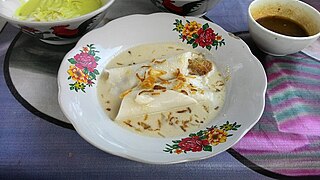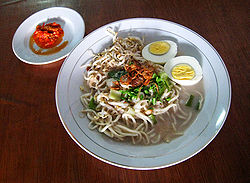
Indonesian cuisine is a collection of various regional culinary traditions that formed in the archipelagic nation of Indonesia. There are a wide variety of recipes and cuisines in part because Indonesia is composed of approximately 6,000 populated islands of the total 17,508 in the world's largest archipelago, with more than 1,300 ethnic groups.

Laksa is a spicy noodle dish popular in Southeast Asia. Laksa consists of various types of noodles, most commonly thick rice noodles, with toppings such as chicken, prawn or fish. Most variations of laksa are prepared with a rich and spicy coconut soup or a broth seasoned with sour asam.

Malay cuisine is the traditional food of the ethnic Malays of Southeast Asia, residing in modern-day Malaysia, Indonesia, Singapore, Brunei, Southern Thailand and the Philippines as well as Cocos Islands, Christmas Island, Sri Lanka and South Africa.

Noodle soup refers to a variety of soups with noodles and other ingredients served in a light broth. Noodle soup is a common dish across East Asia, Southeast Asia and the Himalayan states of South Asia. Various types of noodles are used, such as rice noodles, wheat noodles and egg noodles.

Chinese Indonesian cuisine is characterized by the mixture of Chinese with local Indonesian style. Chinese Indonesians, mostly descendant of Han ethnic Hokkien and Hakka speakers, brought their legacy of Chinese cuisine, and modified some of the dishes with the addition of Indonesian ingredients, such as kecap manis, palm sugar, peanut sauce, chili, santan and local spices to form a hybrid Chinese-Indonesian cuisine. Some of the dishes and cakes share the same style as in Malaysia and Singapore, known as Nyonya cuisine by the Peranakan.

Rice vermicelli is a thin form of noodle. It is sometimes referred to as "rice noodles" or "rice sticks", but should not be confused with cellophane noodles, a different Asian type of vermicelli made from mung bean starch or rice starch rather than rice grains themselves.

Peranakan cuisine or Nyonya cuisine comes from the Peranakans, descendants of early Chinese migrants who settled in Penang, Malacca, Singapore and Indonesia, inter-marrying with local Malays. In Baba Malay, a female Peranakan is known as a nonya, and a male Peranakan is known as a baba. The cuisine combines Chinese, Malay, Javanese, South Indian, and other influences.

Dried shrimp are shrimp that have been sun-dried and shrunk to a thumbnail size. They are used in many East Asian, Southeast Asian and South Asian cuisines, imparting a unique umami taste. A handful of shrimp is generally used for dishes. The flavors of this ingredient are released when allowed to simmer.

Pempek, mpek-mpek and also known as colloquially as empek-empek is a savoury Indonesian fishcake delicacy, made of fish and tapioca, from Palembang, South Sumatera, Indonesia. Pempek is served with rich sweet and sour sauce called kuah cuka or kuah cuko, or just "cuko". Sometimes local people also eat the dish with yellow noodles and diced up cucumber to balance out the vinegar's sourness.

Lontong is an Indonesian dish made of compressed rice cake in the form of a cylinder wrapped inside a banana leaf, commonly found in Indonesia, Malaysia, and Singapore. Rice is rolled inside a banana leaf and boiled, then cut into small cakes as a staple food replacement for steamed rice. The texture is similar to that of ketupat, with the difference being that the ketupat container is made from woven janur fronds, while lontong uses banana leaf instead.

Javanese cuisine is the cuisine of Javanese people, a major ethnic group in Indonesia, more precisely the province of Central Java, Yogyakarta and East Java.

Mie koclok, is an Indonesian chicken noodle soup, a specialty of Cirebon city, West Java. The noodles come with a white-colored extra-thick porridge-like soup, made of chicken broth and coconut milk soup, which is coagulated with corn starch or tapioca. Other ingredients include shredded chicken breast, cabbage, bean sprouts, hard boiled egg, kaffir lime juice, and sprinkled with sliced fresh celery, spring onion, and fried shallot.

Mie kocok, is an Indonesian beef noodle soup, a specialty of Bandung City, West Java. The dish consists of noodles served in rich beef consommé soup, kikil, bean sprouts and bakso, kaffir lime juice, and sprinkled with sliced fresh celery, scallion, and fried shallot. Some recipes might add beef tripe.
Coconut soup is a fruit soup prepared using coconut milk or coconut fruit as a main ingredient. Many varieties of coconut soups exist in the world, including ginataan, laksa, sayur lodeh, soto, and tom kha kai, and myriad ingredients are used. They can be served hot or cold. While most coconut soups are savoury dishes, some varieties—such as binignit and kolak—are sweet dessert soups.

Palembangese cuisine is the cuisine of the Palembangese people of the city of Palembang in the South Sumatra province of Indonesia. It is the second most well-known cuisine from Sumatra after Padang.

Burgo is an Indonesian folded rice pancake served in savoury whitish coconut milk-based soup, flavoured with fish, and sprinkled with fried shallots. The dish is one of the regional specialty of Palembang, the capital of South Sumatra, Indonesia. In Palembang, burgo is a popular choice for breakfast. Burgo is quite similar with lakso, although lakso is thick rice noodles and its soup has yellowish color acquired from turmeric.

Lakso is a spicy Indonesian noodle dish served in savoury yellowish coconut milk-based soup, flavoured with fish, and sprinkled with fried shallots. The dish is one of the regional specialty of Palembang, the capital of South Sumatra, Indonesia.

Mie Gomak is a Batak thick spicy noodle soup dish served in a coconut milk and andaliman-based broth, specialty of Toba Batak region of North Sumatra, Indonesia. Other that traditional Batak lands surrounding Lake Toba, this dish is also a specialty of the Sibolga and Tapanuli area. Unlike common Indonesian noodles, the type of noodle used in this dish is a thick one called mie lidi, quite similar to spaghetti pasta, thus mie gomak is often described as Batak style spaghetti. Mie gomak is quite similar to Mie Aceh from neighbouring province.

Indonesian noodles are a significant aspect of Indonesian cuisine which is itself very diverse. Indonesian cuisine recognizes many types of noodles, with each region of the country often developing its own distinct recipes.


















